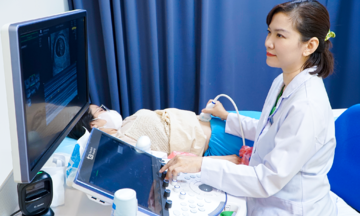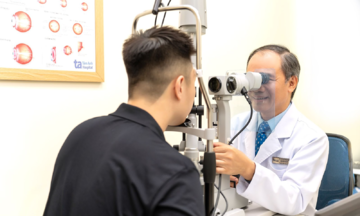David, a Swiss tourist visiting Vietnam, suffered a stroke during his week-long trip and was rushed to Tam Anh General Hospital in Ho Chi Minh City. Dr. Nguyen Anh Dung, head of the Thoracic and Vascular Surgery Department, reported that the patient had an ischemic stroke, lost consciousness, was unresponsive to physical stimuli, experienced complete paralysis on his right side, and had only 20% of his normal muscle strength.
Ischemic stroke occurs when a cerebral artery is narrowed or blocked, interrupting blood flow to the brain. This causes brain cells to be damaged or die within minutes, leading to neurological dysfunction. The patient received thrombolytic medication. After one day, he showed slight movement in his limbs but was still unable to speak. A CT scan of his head and neck revealed 90% stenosis in his left carotid artery.
"This severe narrowing caused a critical lack of blood supply to the left side of the patient's brain, resulting in paralysis of the motor nerves on the right side of his body," Dr. Dung explained, adding that without prompt treatment, the patient could have died or suffered severe long-term complications, including motor, cognitive, language, and vision impairments.
Neurologists and vascular specialists consulted to develop a treatment plan. After 4 days of preparation, surgeons meticulously removed the plaque buildup within the artery, gradually widening the pathway for blood to reach the brain. Brain tissue oxygen monitoring equipment was used during the surgery to continuously assess cerebral blood flow, enabling the anesthesia team to adjust blood pressure to maintain adequate perfusion and prevent further brain damage. After over an hour, the surgical team successfully removed all the plaque, ensuring no fragments remained in the artery.
David began to regain consciousness and responsiveness after the surgery. Three days later, he started physical therapy to restore motor function. After 10 days, he was able to walk normally, speak in relatively clear sentences, and was discharged to return home for further treatment.
 |
A nurse checks David's blood pressure before discharge. Photo: Ha Vu |
A nurse checks David's blood pressure before discharge. Photo: Ha Vu
The carotid arteries are major branches originating from the thoracic aorta, running along both sides of the neck to supply blood to the brain. Carotid artery stenosis occurs when the artery walls thicken due to plaque buildup, narrowing the passage and significantly reducing or interrupting blood flow to the brain. This can cause transient ischemic attacks (TIAs) or, more seriously, ischemic stroke.
The condition often has few symptoms in the early stages. As it progresses, mild symptoms such as dizziness and weakness on one side of the body may appear. More severe cases can lead to sudden loss of consciousness, difficulty speaking, blurred or lost vision in one eye, and hemiplegia, as in David's case.
According to Dr. Dung, if the carotid artery stenosis is only 30-50% and there are no clear symptoms, patients can undergo regular monitoring, manage risk factors, and take prescribed medication to prevent stroke. However, with severe stenosis (above 70-80%), the risk of stroke increases significantly, requiring carotid endarterectomy or stenting.
Individuals with high risk factors for carotid artery stenosis, including lipid disorders, hypertension, diabetes, smoking, family history of carotid or coronary artery disease, obesity, and lack of physical activity, should undergo regular checkups. Patients with carotid artery stenosis who experience sudden symptoms such as facial drooping, hemiplegia or weakness in one or more limbs, difficulty speaking or loss of speech, unilateral vision loss, or balance problems should seek immediate medical attention to minimize long-term complications.
Thu Ha
*The patient's name has been changed.
| Readers can submit questions about cardiovascular diseases here for doctor's answers. |












